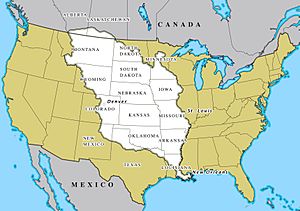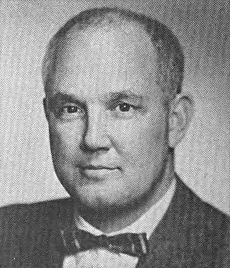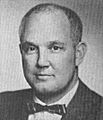Louisiana Purchase Sesquicentennial half dollar facts for kids
The Louisiana Purchase Sesquicentennial half dollar was a special coin that the United States government almost made. It was meant to celebrate the 150th birthday of the Louisiana Purchase, which happened in 1803. Groups from Missouri and Louisiana wanted this coin. They hoped to buy all the coins from the government and sell them to collectors to make money for their anniversary events.
A coin expert named Eric P. Newman from the Missouri Historical Society helped push for this coin. He worked with Congressman Thomas B. Curtis from Missouri. Even though many special coins were made in the 1930s, the government's Treasury Department didn't like making new ones.
When the House of Representatives held a meeting about the coin, a Treasury official, F. Leland Howard, spoke against it. The House still passed the bill in April 1953. The Senate took longer but passed it in January 1954. After both parts of Congress agreed, the bill went to President Dwight D. Eisenhower.
However, President Eisenhower said no to the coin bill on February 3, 1954. He also stopped two other special coin bills. Congress didn't try to make him change his mind. After 1954, the U.S. didn't make any new special coins until 1982.
Contents
Background of the Louisiana Purchase

The Louisiana Purchase was a huge deal for the United States. In 1803, the U.S. bought over a million square miles of land from France for about $15 million. This purchase doubled the size of the country! It opened up a lot of new land for people to move west.
In 1902, President Theodore Roosevelt helped fund a big event called the St. Louis World Fair of 1904. This fair celebrated the 100th anniversary of the Louisiana Purchase. For that event, the government even made special gold dollar coins.
Starting in the 1920s, the U.S. Treasury Department began to dislike the idea of making too many special coins. Many bills for these coins passed Congress in the mid-1930s. Some people felt that these coins were being misused. For example, coin dealers sometimes got to buy all the coins, or the coins were made for many years, like the Oregon Trail Memorial half dollar. In 1939, Congress decided to stop making these multi-year coin series. Later, President Harry S. Truman also said no to some special coin bills.
How the Coin Idea Started
As the 150th anniversary of the Louisiana Purchase got closer, two different groups started trying to get a special half dollar coin made. One group was the Missouri Historical Society (MHS) in Missouri. The other was a group in Louisiana.
On April 24, 1952, Eric P. Newman, a coin expert and leader at the MHS, suggested making a commemorative coin. He thought it could help the society raise $10,000 for their anniversary events. This idea led to talks with Thomas B. Curtis, a congressman from Missouri.
The MHS soon learned that people in Louisiana were also trying to get a coin made. Congressman Hale Boggs from Louisiana had already tried to pass a bill for a coin. Both congressmen introduced their own bills in early 1953. They decided to work together to get a coin bill through Congress. They also encouraged their state groups to work together.
The Coin Meeting
A meeting was held on March 3, 1953, to discuss the coin bills. It took place before the House Banking and Currency Committee. Congressman Curtis spoke first, then Congressman Boggs. Boggs explained the history of the Louisiana Purchase and why it deserved a special coin.
Other people also spoke in favor of the coin. William H. Semsrott, from a St. Louis business group and a director of the Missouri Historical Society, supported the bill. Retired admiral Thomas J. Ryan spoke for the Louisiana group. Both talked about the upcoming celebrations in their states and urged Congress to pass the bill.
However, F. Leland Howard, an Assistant Director of the Mint, spoke against the coins. He said that the Treasury Department's rule was to oppose all special coin bills. He mentioned that in 1903, many Louisiana Purchase gold dollars were made, but most were not sold and had to be melted. He also said that making special half dollars cost more than regular coins. Howard suggested that Congress could approve a medal instead of a coin. A medal would not be used as money and would not cause confusion.
Congressman Boggs argued that the Post Office was making a special stamp for the anniversary, so a coin should also be made. Howard replied that stamps are used differently than coins. After the meeting, Semsrott sent a message saying that the Treasury and Mint were strongly against the coin.
The Bill Passes Congress
On March 10, 1953, the House Banking Committee suggested changes to the bill. These changes would allow both the Missouri and Louisiana groups to buy the coins from the government at their face value. Other non-profit groups from Louisiana Purchase states could also buy them. The plan was to make up to 2,500,000 coins, all at the Philadelphia Mint and dated 1953.
The House of Representatives passed the bill without much discussion on April 13, 1953. Meanwhile, the groups in Missouri and Louisiana continued to talk about how to work together.
In the Senate, the bill went to the Committee on Banking and Commerce. For a while, it seemed like the bill might not pass. But on July 30, Senator J. Glenn Beall recommended that the Senate pass the bill. He said that the small cost of making the coin was worth it. He felt that remembering important parts of U.S. history helps build national pride.
In September, Eric Newman wondered if the bill would ever pass. Congressman Curtis said that Senator Russell B. Long of Louisiana was helping to push the bill forward.
On January 12, 1954, the bill was brought up in the Senate. Senator Long suggested some changes, including that the coins should be dated 1954 instead of 1953. The Senate agreed to the changes and passed the bill. Since the 150th anniversary year had already passed, Newman thought it might be better to honor the Lewis and Clark Expedition on the coin, which started in 1804.
Because the House and Senate passed slightly different versions of the bill, it went back to the House. On January 21, 1954, the House agreed to the Senate's changes. The bill was then signed by the Speaker of the House, Joseph W. Martin Jr., and by Vice President Richard Nixon, who was president of the Senate. Finally, the bill was sent to President Eisenhower.
The President Says No
On February 3, 1954, President Eisenhower said no to the Louisiana Purchase coin bill. He sent it back to the House of Representatives without signing it. He also said no to two other special coin bills for New York City and Northampton, Massachusetts.
In his messages, Eisenhower explained why he said no. He said that people often weren't as interested in these coins as expected. He also worried that making special coins could lead to confusion or even counterfeiting. Eisenhower felt that allowing even one special coin often led to many more requests for other events. He mentioned that President Herbert Hoover had also stopped many such bills in the past.
Congress did not try to make Eisenhower change his mind. Congressman Curtis told Eric Newman about the veto and regretted the outcome. Newman thought Eisenhower might have believed the coins would be used as regular money, not just as souvenirs.
After Eisenhower's vetoes, the U.S. government didn't approve any new special coins until 1981. That year, a bill for the George Washington 250th Anniversary half dollar was passed. These new coins were sold by the government directly, not given to private groups to sell for profit.
Images for kids
-
The Louisiana Purchase (in white) made the U.S. much bigger.




